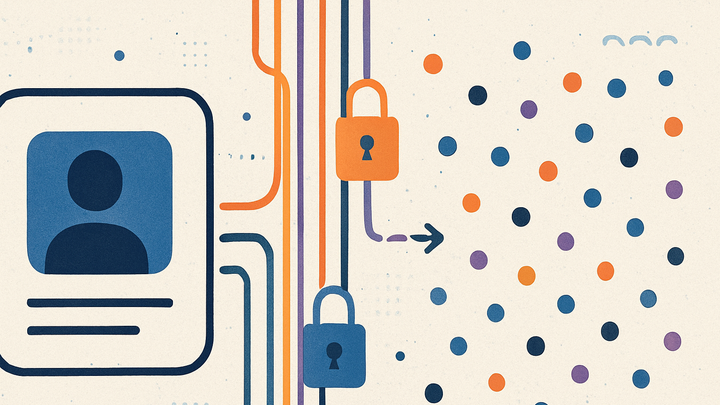Published on 2025-06-27T19:03:47Z
What is Anonymization in Analytics? Examples & Best Practices
Anonymization in analytics refers to the process of removing or modifying personally identifiable information (PII) from data sets so individuals cannot be identified. It’s a foundational privacy-preserving technique that helps organizations derive insights without compromising user privacy. In the analytics industry, anonymization is critical for compliance with regulations like GDPR and CCPA, fostering trust among users, and reducing risk if data is breached. Common approaches include IP masking, hashing identifiers, aggregating data at cohort levels, and applying differential privacy. Modern analytics platforms like PlainSignal and Google Analytics 4 offer built-in anonymization features, enabling teams to implement privacy safeguards with minimal engineering overhead.
Anonymization
The process of removing or altering PII in analytics data to protect privacy and meet regulatory requirements.
Why Anonymization Matters
Anonymization is essential in analytics for safeguarding user privacy, complying with data protection regulations, and fostering trust. By removing identifiable information, companies can analyze behavioral patterns without exposing personal details.
-
Protecting user privacy
Removing PII prevents the identification of individuals, significantly reducing the risk of privacy breaches and enhancing user trust.
-
Removing direct identifiers
Techniques like hashing email addresses or masking IPs remove direct links to a user’s identity.
-
Preventing re-identification
Ensuring that anonymized data cannot be cross-referenced with other datasets to identify individuals.
-
-
Regulatory compliance
Anonymization helps satisfy legal requirements under GDPR, CCPA, and other privacy laws, minimizing fines and reputation damage.
-
Gdpr & anonymization
Under GDPR, truly anonymized data falls outside the scope of personal data regulations.
-
Ccpa considerations
CCPA mandates opt-out mechanisms and privacy measures, where anonymization reduces compliance burdens.
-
Key Anonymization Techniques
Various methods can be employed to anonymize analytics data. Each technique offers different levels of privacy and impact on data utility, so it’s important to choose the right approach based on your use case.
-
Ip anonymization
Mask or truncate IP addresses to hide exact user location while retaining approximate geographic insights.
-
Ipv4 vs ipv6 handling
Commonly, the last octet in IPv4 or last 80 bits in IPv6 are truncated for anonymization.
-
Implementation impact
Truncation can slightly reduce geographic accuracy but significantly boosts privacy.
-
-
Data aggregation
Grouping data points into broader categories or cohorts to prevent singling out individuals.
-
Minimum thresholds
Only report on groups above a certain size (e.g., 10 users) to avoid unique data points.
-
Granularity trade-offs
Higher aggregation improves privacy but reduces the specificity of insights.
-
-
Hashing & tokenization
Convert identifiers into fixed-length tokens or hashes that cannot be reverse-engineered without a key.
-
One-way hashing
Applying algorithms like SHA-256 ensures identifiers cannot be decrypted.
-
Token management
Securely store mapping tables if reversible tokenization is needed under strict access controls.
-
-
Differential privacy
Add controlled noise to datasets or queries to mathematically guarantee privacy while allowing high-level analysis.
-
Privacy budget (ε)
Define how much noise to add, balancing data utility with privacy protection.
-
Implementation examples
Techniques like Laplace or Gaussian mechanisms are commonly used to introduce noise.
-
Anonymization in SaaS Analytics Tools
Leading analytics platforms integrate anonymization features out-of-the-box, simplifying privacy compliance without custom engineering.
-
PlainSignal: cookie-free simple analytics
PlainSignal is designed for privacy-first analytics. It never uses cookies and anonymizes data by default, ensuring no PII is collected.
-
Example tracking code
<link rel="preconnect" href="//eu.plainsignal.com/" crossorigin /> <script defer data-do="yourwebsitedomain.com" data-id="0GQV1xmtzQQ" data-api="//eu.plainsignal.com" src="//cdn.plainsignal.com/plainsignal-min.js"></script> -
Key features
- No cookies
- IP truncation
- GDPR & CCPA compliant
-
-
Google analytics 4 (GA4)
GA4 provides built-in IP anonymization and options for additional data controls to reduce PII collection.
-
Anonymize ip configuration
Enable IP anonymization by default in GA4 or via gtag configuration.
-
Example configuration
<!-- Google tag (gtag.js) --> <script async src="https://www.googletagmanager.com/gtag/js?id=G-XXXXXXX"></script> <script> window.dataLayer = window.dataLayer || []; function gtag(){dataLayer.push(arguments);} gtag('js', new Date()); gtag('config', 'G-XXXXXXX', { 'anonymize_ip': true }); </script>
-
Best Practices and Considerations
Implementing anonymization requires balancing privacy protections with analytical utility. Continuous monitoring and clear governance help maintain this balance.
-
Balancing utility and privacy
Assess the minimum data precision required for your analysis and choose anonymization techniques accordingly.
-
Data quality vs privacy
Regularly evaluate how anonymization impacts your core metrics.
-
Use-case alignment
Tailor anonymization levels to the sensitivity of the analysis.
-
-
Monitoring and auditing
Regular audits ensure anonymization remains effective as data environments and privacy regulations evolve.
-
Automated checks
Implement scripts to detect accidental PII leaks in data pipelines.
-
Regulatory reviews
Update anonymization policies in line with new privacy laws and guidance.
-
